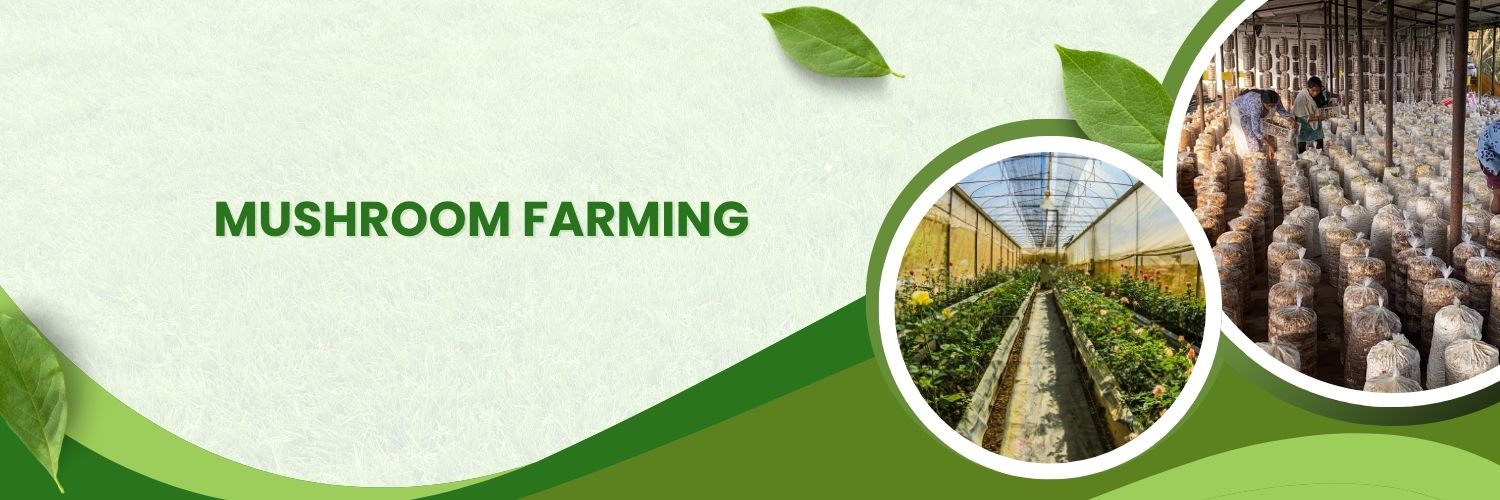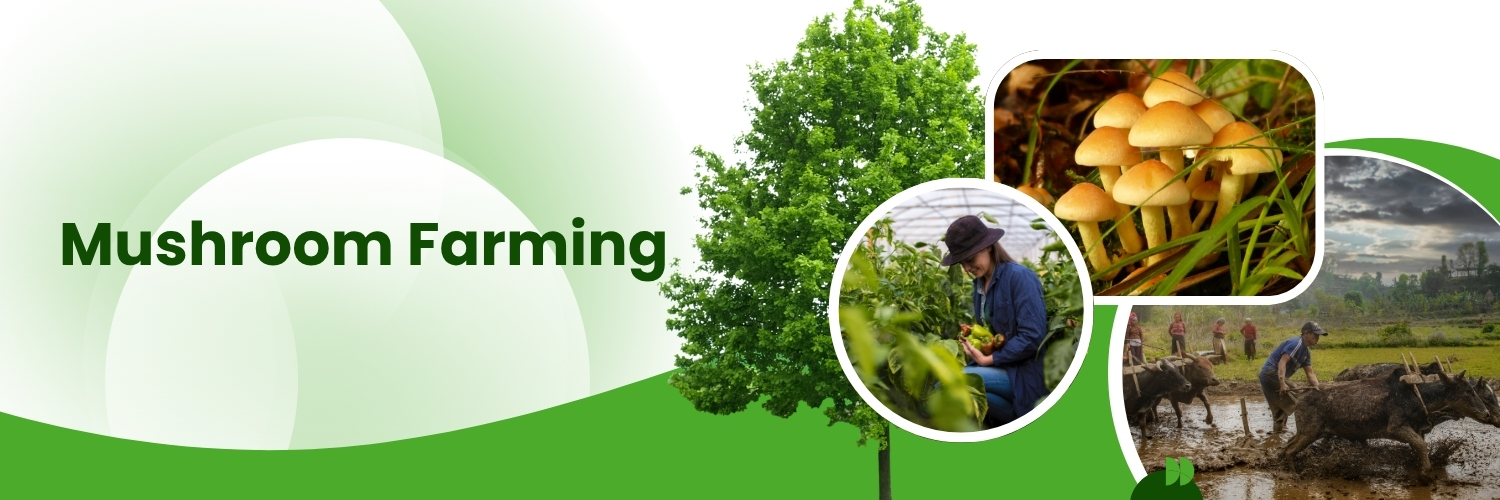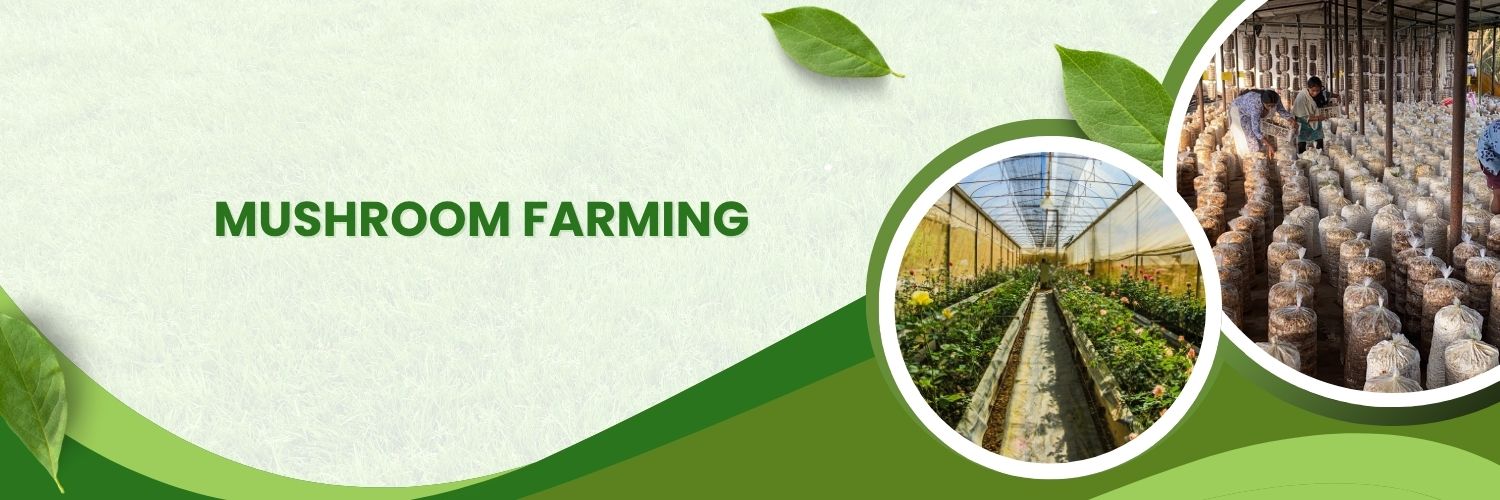Mushroom Farming: Low Investment, High Return

Strong 8k brings an ultra-HD IPTV experience to your living room and your pocket.
In an era marked by shrinking farmland, rising food costs, and the growing impact of climate change on traditional agriculture, mushroom farming is proving to be a smart and sustainable solution. Ideal for small farmers, rural households, and aspiring agripreneurs, it requires minimal land, low investment, and simple infrastructure. With short production cycles and growing demand for nutritious, organic food, mushroom cultivation offers excellent returns in a short time. It can be done in small rooms, sheds, or even at home, making it accessible to all. As it recycles agricultural waste, uses little water, and produces high-protein food, mushroom farming is also environmentally friendly. This low-risk, high-reward agribusiness model is increasingly becoming a path to steady income, food security, and self-employment—especially for those who lack access to large landholdings or expensive farm equipment.
What is Mushroom Farming?
Mushroom farming is the cultivation of edible fungi in controlled environments. Unlike conventional farming, it does not need fertile soil or exposure to sunlight. Mushrooms grow well in dark, moist, and cool spaces, making them ideal for small rooms, sheds, or even basements. This makes mushroom farming a suitable option even in urban and semi-urban areas.
The process involves preparing a growing medium (substrate), inoculating it with mushroom spawn (seeds), maintaining the right humidity and temperature, and harvesting the mature mushrooms in cycles. The most commonly grown varieties in India are Oyster, Button, and Milky mushrooms, with Oyster being the easiest for beginners due to its low maintenance and high yield.
Why Choose Mushroom Farming?
The main attraction of mushroom farming lies in its low investment and high return potential. Unlike other crops that need land preparation, irrigation systems, fertilizers, and long growing periods, mushrooms can be grown indoors, in vertical setups, and harvested within 3 to 4 weeks. A simple setup with bags, racks, or trays, some straw or sawdust, and good hygiene practices is all that’s needed to get started.
Furthermore, mushrooms are in growing demand due to their rich nutritional content. They are a good source of protein, fiber, vitamins (especially B and D), and antioxidants. As health consciousness rises among consumers, mushrooms are finding space in every kitchen, restaurant, and health food store.
Setting Up a Mushroom Farming Unit
Starting a small mushroom farm doesn’t require heavy machinery or large capital. For a beginner, a 10x10 ft room is sufficient to grow 40–50 kg of mushrooms per cycle. The basic requirements are:
• A clean and shaded area with good ventilation
• Polybags or trays for growing
• Straw, sawdust, or similar organic material for substrate
• Mushroom spawn
• Water and humidity control (a simple spray or misting system works well)
The cost of setting up a basic unit can range between ₹30,000 to ₹50,000 depending on scale, materials, and variety grown. Many inputs, like straw and sawdust, are cheap and readily available in rural areas, further reducing investment.
Mushroom Farming Business Plan
A successful mushroom farming venture requires not just cultivation skills but also a well-thought-out mushroom farming business plan. This plan helps determine the feasibility, estimate costs, predict income, and map out marketing and growth strategies.
Here’s what a basic mushroom farming business plan should include:
1. Objective: Set clear goals like scale of operation, monthly mushroom output, and profit targets to guide planning and track business growth.
2. Setup Requirements: Plan space, racks, bags, substrate (like straw), quality spawn, and basic labor to build an efficient and cost-effective mushroom growing unit.
3. Production Plan: Choose mushroom type, estimate yield per cycle, and plan multiple harvests per year to ensure consistent and scalable production.
4. Cost Estimation: Calculate startup costs and monthly expenses for spawn, substrate, water, electricity, and labor to maintain profitability.
5. Revenue Projection: Estimate income by calculating expected yield per month and selling price per kg to forecast monthly and annual earnings.
6. Marketing Strategy: Plan to sell mushrooms in local vegetable markets, restaurants, retail stores, or online platforms to ensure steady demand and cash flow.
7. Risk Factors and Solutions: Identify risks like contamination, pests, climate variation, or delayed inputs, and create backup plans or hygiene practices to reduce losses.
For instance, if a farmer produces 100 kg of oyster mushrooms per month and sells them at ₹120/kg, the revenue is ₹12,000. If the cost of production is ₹4,000–₹5,000, the net profit stands around ₹7,000–₹8,000 monthly, which can be significantly scaled up with expansion.
Market Demand and Sales
Fresh mushrooms have a short shelf life, which makes timely marketing crucial. Fortunately, the demand is constantly rising in cities, hotels, food delivery chains, and supermarkets. Direct-to-customer sales, vegetable markets, and tie-ups with retailers are common strategies. Packaging mushrooms attractively and delivering them fresh can build customer loyalty and premium pricing.
Many mushroom growers also add value by drying mushrooms, packaging them as soup mixes or powders, or pickling them. These products have longer shelf life and fetch better prices, expanding business opportunities.
Training and Skill Development
Though mushroom farming is simple, success requires basic training. Topics like spawn preparation, contamination control, humidity and temperature regulation, and harvesting techniques are crucial. Fortunately, many agricultural universities, Krishi Vigyan Kendras (KVKs), and training centers offer short-term courses, workshops, and online programs in mushroom cultivation.
These programs also provide practical demonstrations, spawn samples, and business tips that help new growers avoid common mistakes and increase yield and quality.
Government Support and Subsidies
The Indian government actively promotes mushroom farming through schemes under the National Horticulture Mission, Mission for Integrated Development of Horticulture (MIDH), and various state agriculture departments. Farmers can avail financial assistance for building mushroom units, setting up spawn labs, and installing composting or drying equipment.
Subsidies and low-interest loans are also available through banks supported by NABARD. These schemes are particularly focused on supporting women, youth, and marginal farmers to encourage self-employment.
Environmental and Social Benefits
Mushroom farming is not just profitable—it’s also environmentally responsible. It uses agricultural waste (like straw, husk, or sawdust) as raw material and requires very little water compared to conventional crops. The waste left after harvesting (called spent substrate) is a nutrient-rich compost that can be used to fertilize fields or gardens.
Socially, mushroom farming has empowered thousands of women in rural areas through self-help groups. It’s also helped unemployed youth and retired professionals to create a steady income stream with limited resources.
Conclusion
Mushroom farming is more than just a trend—it's a growing opportunity in the agricultural economy. It provides high returns on a modest investment, suits both urban and rural settings, and aligns with the modern market’s demand for health and sustainability. With proper planning, training, and a sound mushroom farming business plan, even a small-scale grower can build a steady, scalable, and sustainable agribusiness.
Whether you are a farmer looking to diversify your income, a homemaker searching for a home-based venture, or an aspiring agripreneur ready to tap into a profitable niche, mushroom farming could be your gateway to success.
Note: IndiBlogHub features both user-submitted and editorial content. We do not verify third-party contributions. Read our Disclaimer and Privacy Policyfor details.







